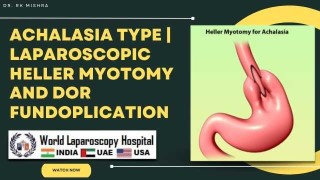Minimally Invasive Hysterectomy with Cystoscopy and Infrared Ureteric Guidance
Add to
Share
1,408 views
Report
1 year ago
Description
Introduction Total Laparoscopic Hysterectomy (TLH) is a minimally invasive surgical procedure to remove the uterus. It offers patients benefits such as reduced postoperative pain, shorter hospital stays, and quicker recovery times compared to traditional open surgery. When combined with cystoscopy and infrared ureteric catheterization, TLH can be performed with enhanced precision and safety, particularly in complex cases where the risk of ureteral injury is higher. Procedure Details 1. Total Laparoscopic Hysterectomy (TLH) TLH involves the removal of the uterus through small incisions in the abdomen using a laparoscope, a thin, lighted tube with a camera. The procedure generally follows these steps: - Anesthesia: The patient is placed under general anesthesia. - Incision and Access: Small incisions are made in the abdominal wall, through which the laparoscope and other surgical instruments are inserted. - Visualization and Dissection: The laparoscope transmits images to a monitor, allowing the surgeon to visualize the pelvic organs. The uterus is then detached from its surrounding structures, including the ovaries, fallopian tubes, and supporting ligaments. - Removal: The uterus is morcellated (cut into smaller pieces) and removed through the incisions. 2. Cystoscopy Cystoscopy is a procedure that allows the surgeon to examine the inside of the bladder and urethra using a cystoscope, a thin, tube-like instrument with a light and camera. This step is crucial in TLH to ensure there are no injuries to the bladder or urethra during the hysterectomy. It involves: - Bladder Examination: The cystoscope is inserted through the urethra into the bladder, allowing the surgeon to inspect the bladder lining and identify any potential injuries or abnormalities. - Ureteral Orifices Inspection: The openings of the ureters into the bladder are examined to ensure there is no damage and that urine flow is unimpeded. 3. Infrared Ureteric Catheterization Infrared ureteric catheterization enhances the safety of TLH by providing real-time visualization of the ureters, reducing the risk of accidental injury. The process includes: - Catheter Placement: Infrared ureteric catheters are inserted into the ureters via the bladder. These catheters emit infrared light, which can be detected using a specialized laparoscopic camera. - Visualization: The infrared signal allows the surgeon to clearly see the ureters throughout the procedure, ensuring they are not damaged during the dissection and removal of the uterus. Benefits and Advantages Combining TLH with cystoscopy and infrared ureteric catheterization offers several advantages: - Enhanced Safety: The use of cystoscopy and infrared technology significantly reduces the risk of ureteral and bladder injuries, which are potential complications in hysterectomy procedures. - Improved Outcomes: The precise visualization and careful handling of the ureters and bladder result in fewer complications and better postoperative outcomes. - Minimally Invasive: TLH is less invasive than traditional abdominal hysterectomy, leading to shorter hospital stays, less postoperative pain, and faster recovery times. Indications and Contraindications Indications: - Benign conditions such as fibroids, endometriosis, and adenomyosis. - Premalignant or early-stage malignant conditions of the uterus. - Severe pelvic pain or abnormal bleeding unresponsive to other treatments. Contraindications: - Advanced malignant disease where a more extensive surgical approach is required. - Severe pelvic adhesions or anatomy that complicates laparoscopic access. - Patients unfit for surgery due to other medical conditions. Postoperative Care and Recovery - Immediate Postoperative Care: Patients are monitored for any signs of complications such as bleeding or infection. Pain management and early mobilization are important to aid recovery. - Follow-Up: Regular follow-up visits are scheduled to monitor the patient’s recovery, address any concerns, and ensure proper healing. - Recovery Timeline: Most patients can resume normal activities within a few weeks, though full recovery may take up to six weeks. Patients are advised to avoid heavy lifting and strenuous activities during this period. Conclusion Total Laparoscopic Hysterectomy with cystoscopy and infrared ureteric catheterization represents a significant advancement in gynecological surgery, combining minimally invasive techniques with enhanced safety measures. This approach provides a comprehensive solution for treating various uterine conditions, ensuring optimal patient outcomes with minimal risk. As technology and surgical techniques continue to evolve, these procedures will likely become the standard of care, offering even greater benefits to patients undergoing hysterectomy.
Similar Videos






